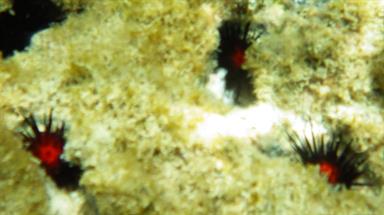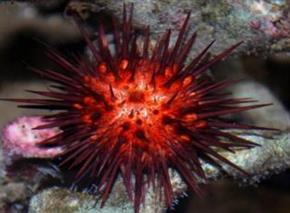



Echinometra lucunter
Size
To 8 cm across the test (body)
Description:
The body of this species is elliptical in outline, not round, with 100-150 spines. The black spines are short, thick and sharply pointed. The color of the body and the spines is usually red, but it can vary from almost black with shades of purple or green.
Ecology
Found abundantly in shallow waters in a variety of habitats such as tropical, marine intertidal or littoral. It lives in cavities in wave-exposed areas such as tidal terraces, beachrock as well as in less energetic habitats (non-wave-exposed areas) which include
other areas of rocky shore from just below the low tide level to depths of 45m. It may even be found under rock slabs. It is highly territorial, and may even resort to aggression as its primary line of defence to protect its access to food and living space. Echinometra lucunter seldom moves out of its burrow, but when it does, movement is primarily seen during the night. It is frequently found in groups of up to 240 individuals per m2 but with clearly defined boundaries between each burrow.
It grazes on the non-living reef structure as well as on live coral surfaces. 95% of E. lucunter’s diet consists of algae such as Laurencia
papillosa and the other 2% are invertebrates that were probably ingested accidentally, such as the sponge Darwinella. It is also known to consume some seagrasses.
Life Cycle
Mmales reach maturity from 18mm and females from 21mm in diameter, and spawning usually occurs once a year. Mating is polygamous, with one female mating with several males, since eggs and sperms are both released into the water column. The male releases spermatocytes first into the column, which is detected by the female who then releases her eggs.
To 8 cm across the test (body)
Description:
The body of this species is elliptical in outline, not round, with 100-150 spines. The black spines are short, thick and sharply pointed. The color of the body and the spines is usually red, but it can vary from almost black with shades of purple or green.
Ecology
Found abundantly in shallow waters in a variety of habitats such as tropical, marine intertidal or littoral. It lives in cavities in wave-exposed areas such as tidal terraces, beachrock as well as in less energetic habitats (non-wave-exposed areas) which include
other areas of rocky shore from just below the low tide level to depths of 45m. It may even be found under rock slabs. It is highly territorial, and may even resort to aggression as its primary line of defence to protect its access to food and living space. Echinometra lucunter seldom moves out of its burrow, but when it does, movement is primarily seen during the night. It is frequently found in groups of up to 240 individuals per m2 but with clearly defined boundaries between each burrow.
It grazes on the non-living reef structure as well as on live coral surfaces. 95% of E. lucunter’s diet consists of algae such as Laurencia
papillosa and the other 2% are invertebrates that were probably ingested accidentally, such as the sponge Darwinella. It is also known to consume some seagrasses.
Life Cycle
Mmales reach maturity from 18mm and females from 21mm in diameter, and spawning usually occurs once a year. Mating is polygamous, with one female mating with several males, since eggs and sperms are both released into the water column. The male releases spermatocytes first into the column, which is detected by the female who then releases her eggs.

| Ecological Descriptors | ||||
| Habitat | Size (cm) | Diet | Behaviour | Sex |
| R | 8 (body) |
Veg, Noct | I, Ter | F |
Rock Boring Urchin


(C) S Coppard 2010
264
Rock Boring Urchin



